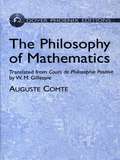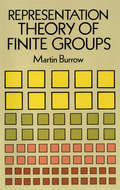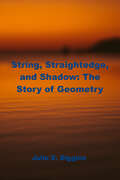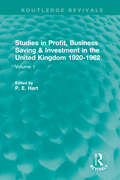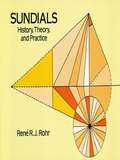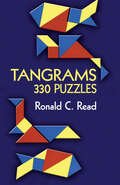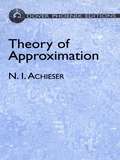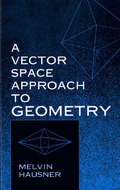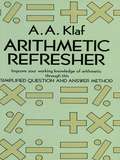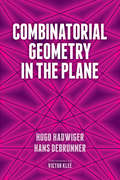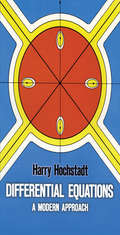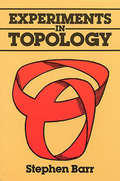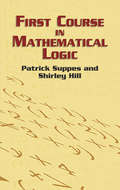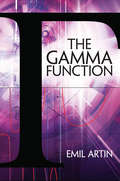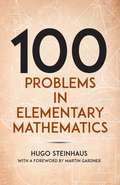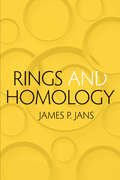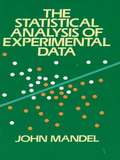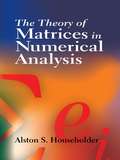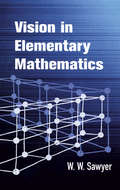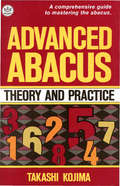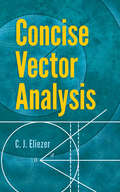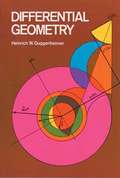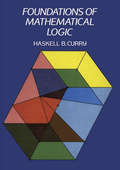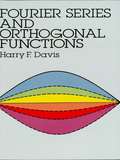- Table View
- List View
The Philosophy of Mathematics: Translated from Cours de Philosophie Positive by W. M. Gillespie
by Auguste ComteWritten by the nineteenth-century French philosophical founder of positivism, this comprehensive map of mathematical science assigns to each part of the complex whole its true position and value. The two-part treatment begins with a general view of mathematical analysis and advances to algebra, continuing with an exploration of geometry's ancient and modern methods.
Representation Theory of Finite Groups
by Martin BurrowConcise, graduate-level exposition of the theory of finite groups, including the theory of modular representations. Topics include representation theory of rings with identity, representation theory of finite groups, applications of the theory of characters, construction of irreducible representations and modular representations. Rudiments of linear algebra and knowledge of group theory helpful prerequisites. Exercises. Bibliography. Appendix. 1965 edition.
String, Straightedge, and Shadow: The Story of Geometry
by Julia E. DigginsThis book explains how the basic principles of elementary geometry were discovered over 2,000 years ago. Indicates the major roles played by the early civilizations of Mesopotamia, Egypt, and Greece.
Studies in Profit, Business Saving and Investment in the United Kingdom 1920-1962: Volume 1 (Routledge Revivals)
by P. E. HartThe results of the 1959 Glasgow University investigation into British industrial profit, business saving, and investment are the subject of this book, originally published in 1965. Part 1 presents original estimates of profits in British industries 1920-1938, which when linked with Government estimates of such profits since 1948, permit long runs studies of the fortunes of individual industries. In addition, the appropriation of profit between dividends and business saving is also estimated for manufacturing industry 1920-1938. Part 2 begins the analysis of the extensive financial data collected in the Glasgow enquiry and is concerned with the effects of the size of a firm on its financial performance. The financial performance of large companies quoted on the Stock Exchange with a sample of small unquoted private companies and unincorporated firms is compared.
Sundials: History, Theory, and Practice
by René R.J. Rohr"His lively pen, his direct and simple style, his expressive vocabulary, his avoidance of pedantry, his conciseness in the exposition of his thoughts make his book a pleasure to read." -- Henri Michel, International Academy of the History of ScienceThe story of man's efforts to measure time is a long one -- reaching back thousands of years to the dawn of civilization. Among the earliest instruments developed for telling time was the sundial. In this expert study, a noted sundial expert offers a fascinating and informative account of these ancient devices, presented in simple, lively language.Over the centuries, many different varieties of sundials have been constructed, and Mr. Rohr provides detailed, accurate descriptions of them all: classical sundials, inclined dials, solar calendars, analemmatic dials, moon dials, and many more. There is even a chapter devoted to especially remarkable dials past and present, and a listing of the most popular sundial mottoes. In this profusely illustrated volume, you will not only learn about the long and colorful history of the sundial, you will learn a practical method of building one yourself. No special knowledge is required, other than an understanding of the basic principles of cosmography and of the relative movements of the sun and the planets. (These are recalled in an elementary way in a special chapter.) For mathematically inclined readers, more complex formulae and calculations have been included, some of which have never been printed in a book of gnomonics.
Tangrams: 330 Puzzles (Dover Recreational Math)
by Ronald C. ReadThis collection gathers together nearly 330 tangrams, the best creations of both Chinese and Occidental puzzle devisers. Included are puzzles carefully selected from rare 19th-century books and some of the most inventive and imaginative inventions of Loyd and Dudeney. Tangrams range from the relatively easy to the difficult.
Theory of Approximation (Dover Books on Mathematics)
by N. I. AchieserA pioneer of many modern developments in approximation theory, N. I. Achieser designed this graduate-level text from the standpoint of functional analysis. The first two chapters address approximation problems in linear normalized spaces and the ideas of P. L. Tchebysheff. Chapter III examines the elements of harmonic analysis, and Chapter IV, integral transcendental functions of the exponential type. The final two chapters explore the best harmonic approximation of functions and Wiener's theorem on approximation. Professor Achieser concludes this exemplary text with an extensive section of problems and applications (elementary extremal problems, Szego's theorem, the Carathéodory-Fejér problem, and more).
A Vector Space Approach to Geometry (Dover Books on Mathematics)
by Melvin HausnerThe effects of geometry and linear algebra on each other receive close attention in this examination of geometry's correlation with other branches of math and science. In-depth discussions include a review of systematic geometric motivations in vector space theory and matrix theory; the use of the center of mass in geometry, with an introduction to barycentric coordinates; axiomatic development of determinants in a chapter dealing with area and volume; and a careful consideration of the particle problem. 1965 edition.
Arithmetic Refresher (Dover Books on Mathematics)
by A. A. KlafThe farther we get from our grade school days, the easier it is to forget those operations and nuances of arithmetical computation that keep recurring in our daily lives: interest and discount problems, time-payment calculations, tax problems, and so on.This handy book is designed to streamline your methods and resharpen your calculation skills for a variety of situations. Starting with the most elementary operations, the book goes on to cover all basic topics and processes of arithmetic: addition, subtraction, multiplication, division, fractions, percentage, interest, ratio and proportion, denominate numbers, averages, etc. The text continues into other useful matters, such as powers and roots, logarithms, positive and negative numbers, harmonic progression, and introductory concepts of algebra.Entirely practical in approach and using an easy-to-follow question and answer style, this book covers a wide range of common knotty areas: filling and emptying receptacles, scales for models and maps, business and financial calculations (partial payment problems, compound interest, bank and sales discount, profit and loss problems, etc.), angle measurement, mixtures and solutions, graph and chart problems, and the like.The discussion contains numerous alternate and short-cut methods, such as quick ways to figure compound interest; to square a number from 1 to 100; to divide by 5, 25, 125, 99, etc.; to multiply two 2-digit numbers having the same figure in the tens place; and many more. These valuable tips, together with the huge fund of exercise problems (a total of 809, half of them answered in an appendix), help you to increase your computational proficiency and speed, and make this an extremely useful volume to have on your shelf at home or at work. Anyone who has to do any figuring at all -- housewife, merchant, student -- will profit from this refresher. Parents will find it an excellent source of material for helping children in school work.
Combinatorial Geometry in the Plane (Dover Books on Mathematics)
by Hans Debrunner Hugo Hadwiger Victor KleeGeared toward advanced undergraduates familiar with analysis and college geometry, this concise book discusses theorems on topics restricted to the plane such as convexity, coverings, and graphs. In addition to helping students cultivate rigorous thought, the text encourages the development of mathematical intuition and clarifies the nature of mathematical research.The two-part treatment begins with specific topics including integral distances, covering problems, point set geometry and convexity, simple paradoxes involving point sets, and pure combinatorics, among other subjects. The second part consists of an extensive section of short proofs concerning the earlier material.
A Course in Modern Mathematical Physics
by Peter SzekeresPresenting an introduction to the mathematics of modern physics for advanced undergraduate and graduate students, this textbook introduces the reader to modern mathematical thinking within a physics context. Topics covered include tensor algebra, differential geometry, topology, Lie groups and Lie algebras, distribution theory, fundamental analysis and Hilbert spaces. The book also includes exercises and proofed examples to test the students' understanding of the various concepts, as well as to extend the text's themes.
Differential Equations
by Harry HochstadtModern approach to differential equations presents subject in terms of ideas and concepts rather than special cases and tricks which traditional courses emphasized. No prerequisites needed other than a good calculus course. Certain concepts from linear algebra used throughout. Problem section at end of each chapter.
Experiments in Topology
by Stephen Barr"A mathematician named KleinThought the Moebius band was divine.Said he: 'If you glueThe edges of two,You'll get a weird bottle like mine.' " -- Stephen BarrIn this lively book, the classic in its field, a master of recreational topology invites readers to venture into such tantalizing topological realms as continuity and connectedness via the Klein bottle and the Moebius strip. Beginning with a definition of topology and a discussion of Euler's theorem, Mr. Barr brings wit and clarity to these topics:New Surfaces (Orientability, Dimension, The Klein Bottle, etc.)The Shortest Moebius StripThe Conical Moebius StripThe Klein BottleThe Projective Plane (Symmetry)Map ColoringNetworks (Koenigsberg Bridges, Betti Numbers, Knots)The Trial of the Punctured TorusContinuity and Discreteness ("Next Number," Continuity, Neighborhoods, Limit Points)Sets (Valid or Merely True? Venn Diagrams, Open and Closed Sets, Transformations, Mapping, Homotopy)With this book and a square sheet of paper, the reader can make paper Klein bottles, step by step; then, by intersecting or cutting the bottle, make Moebius strips. Conical Moebius strips, projective planes, the principle of map coloring, the classic problem of the Koenigsberg bridges, and many more aspects of topology are carefully and concisely illuminated by the author's informal and entertaining approach.Now in this inexpensive paperback edition, Experiments in Topology belongs in the library of any math enthusiast with a taste for brainteasing adventures in the byways of mathematics.
First Course in Mathematical Logic (Dover Books on Mathematics)
by Patrick Suppes Shirley HillIn modern mathematics, both the theory of proof and the derivation of theorems from axioms bear an unquestioned importance. The necessary skills behind these methods, however, are frequently underdeveloped. This book counters that neglect with a rigorous introduction that is simple enough in presentation and context to permit relatively easy comprehension. It comprises the sentential theory of inference, inference with universal quantifiers, and applications of the theory of inference developed to the elementary theory of commutative groups. Throughout the book, the authors emphasize the pervasive and important problem of translating English sentences into logical or mathematical symbolism. Their clear and coherent style of writing ensures that this work may be used by students in a wide range of ages and abilities.
The Gamma Function (Dover Books on Mathematics)
by Emil Artin Michael ButlerThis brief monograph on the gamma function was designed by the author to fill what he perceived as a gap in the literature of mathematics, which often treated the gamma function in a manner he described as both sketchy and overly complicated. Author Emil Artin, one of the twentieth century's leading mathematicians, wrote in his Preface to this book, "I feel that this monograph will help to show that the gamma function can be thought of as one of the elementary functions, and that all of its basic properties can be established using elementary methods of the calculus." Generations of teachers and students have benefitted from Artin's masterly arguments and precise results. Suitable for advanced undergraduates and graduate students of mathematics, his treatment examines functions, the Euler integrals and the Gauss formula, large values of x and the multiplication formula, the connection with sin x, applications to definite integrals, and other subjects.
One Hundred Problems in Elementary Mathematics (Dover Books on Mathematics)
by Martin Gardner Hugo SteinhausBoth a challenge to mathematically inclined readers and a useful supplementary text for high school and college courses, One Hundred Problems in Elementary Mathematics presents an instructive, stimulating collection of problems. Many problems address such matters as numbers, equations, inequalities, points, polygons, circles, ellipses, space, polyhedra, and spheres. An equal number deal with more amusing or more practical subjects, such as a picnic ham, blood groups, rooks on a chessboard, and the doings of the ingenious Dr. Abracadabrus.Are the problems in this book really elementary? Perhaps not in the lay reader’s sense, for anyone who desires to solve these problems must know a fair amount of mathematics, up to calculus. Nevertheless, Professor Steinhaus has given complete, detailed solutions to every one of his 100 problems, and anyone who works through the solutions will painlessly learn an astonishing amount of mathematics. A final chapter provides a true test for the most proficient readers: 13 additional unsolved problems, including some for which the author himself does not know the solutions.
Rings and Homology (Dover Books on Mathematics)
by James P. JansThis concise text is geared toward students of mathematics who have completed a basic college course in algebra. Combining material on ring structure and homological algebra, the treatment offers advanced undergraduate and graduate students practice in the techniques of both areas. After a brief review of basic concepts, the text proceeds to an examination of ring structure, with particular attention to the structure of semisimple rings with minimum condition. Subsequent chapters develop certain elementary homological theories, introducing the functor Ext and exploring the various projective dimensions, global dimension, and duality theory. Each chapter concludes with a set of exercises.
The Statistical Analysis of Experimental Data
by John MandelThe increasing importance in laboratory situations of minutely precise measurements presents the chemist and physicist with numerous problems in data analysis. National Bureau of Standards statistics consultant John Mandel here draws a clear and fascinating blueprint for a systematic science of statistical analysis -- geared to the particular needs of the physical scientist, with approach and examples aimed specifically at the statistical problems he is likely to confront. The first third of The Statistical Analysis of Experimental Data comprises a thorough grounding in the fundamental mathematical definitions, concepts, and facts underlying modern statistical theory -- math knowledge beyond basic algebra, calculus, and analytic geometry is not required. Remaining chapters deal with statistics as an interpretative tool that can enable the laboratory researcher to determine his most effective methodology. You'll find lucid, concise coverage of over 130 topics, including elements of measurement; nature of statistical analysis; design/analysis of experiments; statistics as diagnostic tool; precision and accuracy; testing statistical models; between-within classifications; two-way classifications; sampling (principles, objectives, methods); fitting of non-linear models; measurement of processes; components of variance; nested designs; the sensitivity ratio, and much more.Also included are many examples, each worked in step-by-step fashion; nearly 200 helpful figures and tables; and concluding chapter summaries followed by references for further study.Mandel argues that, when backed by an understanding of its theoretic framework, statistics offers researchers "not only a powerful tool for the interpretation of experiments but also a task of real intellectual gratification." The Statistical Analysis of Experimental Data provides the physical scientist with the explanations and models he requires to impress this invaluable tool into service.
The Theory of Matrices in Numerical Analysis
by Alston S. HouseholderThis text explores aspects of matrix theory that are most useful in developing and appraising computational methods for solving systems of linear equations and for finding characteristic roots. Suitable for advanced undergraduates and graduate students, it assumes an understanding of the general principles of matrix algebra, including the Cayley-Hamilton theorem, characteristic roots and vectors, and linear dependence.An introductory chapter covers the Lanczos algorithm, orthogonal polynomials, and determinantal identities. Succeeding chapters examine norms, bounds, and convergence; localization theorems and other inequalities; and methods of solving systems of linear equations. The final chapters illustrate the mathematical principles underlying linear equations and their interrelationships. Topics include methods of successive approximation, direct methods of inversion, normalization and reduction of the matrix, and proper values and vectors. Each chapter concludes with a helpful set of references and problems.
Vision in Elementary Mathematics (Dover Books on Mathematics)
by W. W. SawyerHere is a presentation of elementary mathematics that anyone can appreciate, especially anyone with a capacity for imagination. As the title suggests, the author's technique relies on visual elements, and his approach employs the most graphic and least forbidding aspects of mathematics. Most people, he observes, possess a direct vision that permits them to "see" the smaller numbers; with the larger numbers, however, vision fails and mental chaos ensues. In addressing this difficulty, both for those who like recreational mathematics and particularly for teachers, the author suggests a variety of methods already used by many effective teachers -- techniques of visualizing, dramatizing, and analyzing numbers that attract and retain the attention and understanding of children. His topics range from basic multiplication and division to algebra, encompassing word problems, graphs, negative numbers, fractions, and many other practical applications of elementary mathematics.
Advanced Abacus
by Takashi KojimaThis volume is designed for the student desiring a greater understanding of the abacus and its calculative functions. The text provides thorough explanations of the advanced operations involving negative numbers, decimals, different units of measurement, and square roots. Diagrams illustrate bead manipulation, and numerous exercises provide ample practice. Concise and easy-to-follow, this book will improve your abacus skills and help you perform calculations with greater efficiency and precision.
Concise Vector Analysis: Mathematics Division : Concise Vector Analysis (Dover Books on Mathematics)
by C. J. EliezerThis concise introduction to the methods and techniques of vector analysis is suitable for college undergraduates in mathematics as well as students of physics and engineering. Rich in exercises and examples, the straightforward presentation focuses on physical ideas rather than mathematical rigor. The treatment begins with a chapter on vectors and vector addition, followed by a chapter on products of vector. Two succeeding chapters on vector calculus cover a variety of topics, including functions of a vector; line, surface, and volume integrals; the Laplacian operator, and more. The text concludes with a survey of standard applications, including Poinsot's central axis, Gauss's theorem, gravitational potential, Green's theorems, and other subjects.
Differential Geometry
by Heinrich W. GuggenheimerThis is a text of local differential geometry considered as an application of advanced calculus and linear algebra. The discussion is designed for advanced undergraduate or beginning graduate study, and presumes of readers only a fair knowledge of matrix algebra and of advanced calculus of functions of several real variables. The author, who is a Professor of Mathematics at the Polytechnic Institute of New York, begins with a discussion of plane geometry and then treats the local theory of Lie groups and transformation groups, solid differential geometry, and Riemannian geometry, leading to a general theory of connections. The author presents a full development of the Erlangen Program in the foundations of geometry as used by Elie Cartan as a basis of modern differential geometry; the book can serve as an introduction to the methods of E. Cartan. The theory is applied to give a complete development of affine differential geometry in two and three dimensions. Although the text deals only with local problems (except for global problems that can be treated by methods of advanced calculus), the definitions have been formulated so as to be applicable to modern global differential geometry. The algebraic development of tensors is equally accessible to physicists and to pure mathematicians. The wealth of specific resutls and the replacement of most tensor calculations by linear algebra makes the book attractive to users of mathematics in other disciplines.
Foundations of Mathematical Logic
by Haskell B. CurryThis book is a thoroughly documented and comprehensive account of the constructive theory of the first-order predicate calculus. This is a calculus that is central to modern mathematical logic and important for mathematicians, philosophers, and scientists whose work impinges upon logic.Professor Curry begins by asking a simple question: What is mathematical logic? If we can define logic as "the analysis and criticism of thought" (W. E. Johnson), then mathematical logic is, according to Curry, "a branch of mathematics which has much the same relation to the analysis and criticism of thought as geometry does to the science of space."The first half of the book gives the basic principles and outlines of the field. After a general introduction to the subject, the author discusses formal methods including algorithms and epitheory. A brief treatment of the Markov treatment of algorithms is included here. The elementary facts about lattices and similar algebraic systems are then covered. In the second half of the book Curry investigates the possibility for a formulation that expresses the meaning to be attached to the logical connectives and to develop the properties that follow from the assumptions so motivated. The author covers positive connectives: implication, conjunction, and alternation. He then goes on to negation and quantification, and concludes with modal operations. Extensive use is made in these latter chapters of the work of Gentzen. Lists of exercises are included.Haskell B. Curry, Evan Pugh Research Professor, Emeritus, at Pennsylvania State University, was a member of the Institute for Advanced Study, Princeton; a former Director of the Institute for Foundational Research, the University of Amsterdam; and President of the Association for Symbolic Logic. His book avoids a doctrinaire stance, presenting various interpretations of logical systems, and offers philosophical and reflective as well as mathematical perspectives.
Fourier Series and Orthogonal Functions (Dover Books on Mathematics)
by Harry F. DavisThis incisive text deftly combines both theory and practical example to introduce and explore Fourier series and orthogonal functions and applications of the Fourier method to the solution of boundary-value problems. Directed to advanced undergraduate and graduate students in mathematics as well as in physics and engineering, the book requires no prior knowledge of partial differential equations or advanced vector analysis. Students familiar with partial derivatives, multiple integrals, vectors, and elementary differential equations will find the text both accessible and challenging. The first three chapters of the book address linear spaces, orthogonal functions, and the Fourier series. Chapter 4 introduces Legendre polynomials and Bessel functions, and Chapter 5 takes up heat and temperature. The concluding Chapter 6 explores waves and vibrations and harmonic analysis. Several topics not usually found in undergraduate texts are included, among them summability theory, generalized functions, and spherical harmonics. Throughout the text are 570 exercises devised to encourage students to review what has been read and to apply the theory to specific problems. Those preparing for further study in functional analysis, abstract harmonic analysis, and quantum mechanics will find this book especially valuable for the rigorous preparation it provides. Professional engineers, physicists, and mathematicians seeking to extend their mathematical horizons will find it an invaluable reference as well.
